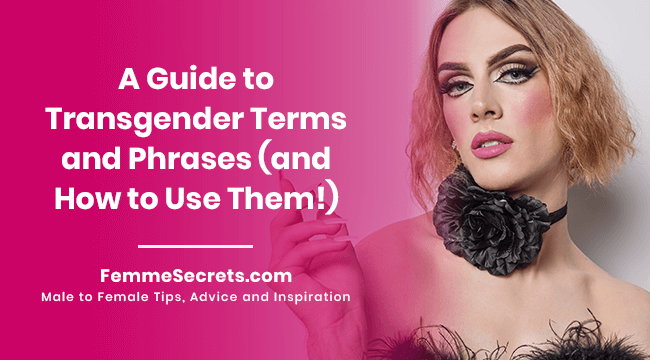
Using the proper terms to address transgender people is an important way to show respect.
But, if you’ve ever felt confused or unsure about all the different terms and phrases used in the trans community, you are not alone!
That’s why I’ve put together this guide on some of the most commonly used transgender terminology.
Keep in mind that everybody’s journey is different and people may have their own preferences for how they are addressed. When in doubt, it’s always best to ask.
That said, let’s dive in and explore the world of transgender terminology!
Transgender Terms and Phrases
- Agender: This is a term that is used to describe an individual who doesn’t identify with a specific gender.
- Ally: This is any individual actively supporting LGBTQA (Lesbian, Gay, Bisexual, Transgender, Queer, or Asexual) people and their causes.
- Assigned Female at Birth (AFAB): This is an individual who was assigned a female gender at birth.
- Assigned Male at Birth (AMAB): This is a person who was assigned a male gender at birth.
- Assigned sex at birth: This is the sex (typically male or female) that was assigned to an individual at birth based on their external genitalia.
- Bi-gendered: This adjective describes someone who has a strong gender identity that includes both genders, female and male. Some bi-gendered individuals may feel that one side is stronger than the other, but both sides exist.
- Cisgender, Cis: The term “cisgender” refers to a person whose gender identity aligns with the sex they were assigned at birth. Cis is a Latin prefix that means “on the same side.”
- Crossdresser: This term refers to people who dress in clothes that are traditionally worn by the opposite sex. However, these people are unlikely to live as the opposite gender full-time.
- Drag king: This term describes women who dress as men in order to entertain others at clubs, bars, or other events.
- Drag queen: This term describes men who dress as women for the purpose of entertaining others at clubs, bars, or other events.
- FTM: A female-to-male transgender individual, also known as a transgender man, is someone who was born in the female gender but identifies themselves on the male spectrum.
- Gender affirming: This is an adjective referring to actions or interventions that confirm a transgender person’s gender identity. Examples include a doctor prescribing hormones to a transgender patient, or an individual using a correctly gendered pronoun.
- Gender-affirming hormone therapy (GAHT): Gender-affirming hormone therapy, also known as hormone replacement therapy (HRT), is a medical treatment that uses hormones to help transgender people align their physical characteristics with their gender identity.
- Gender-affirming surgery (GAS): This is a surgical procedure that alters a person’s body to match their gender identity. This could involve altering genitalia or breast augmentation or removal. It is also known as sex reassignment surgery (SRS) or gender confirmation surgery (GCS).
- Gender dysphoria: Gender dysphoria is psychological distress caused by a mismatch between one’s sex at birth and their gender identity. Some trans people don’t experience dysphoria, and the ones who do may have varying degrees of intensity.
- Gender expansive: This is a person who has a broader and more flexible range of gender expression and/or identity than the binary gender system. This term is frequently used as an umbrella term when referring to young people who are still exploring their gender identity and/or gender expression.
- Gender expression: This term refers to the external behaviors and traits that represent a person’s gender identity, such as clothing, speech, and mannerisms. It may not align with cultural norms; for instance, not all trans women are traditionally feminine. This is also called “gender presentation.”
- Gender fluid: This term describes an individual who doesn’t identify with any single fixed gender or who has an unfixed gender identity.
- Gender identity: This term refers to a person’s deeply felt, internal sense of their gender, which may or may not correspond with the sex they were assigned at birth. Since gender identity is internal, it is not necessarily clear to others.
- Gender pronouns: Gender pronouns, also known as personal pronouns, are the words used to refer to someone in the third person. Common gender pronouns include “he/him/his” for males, “she/her/hers” for females, and “they/them/theirs” for non-binary individuals.
- Gender non-conforming: This term describes individuals whose gender expression differs from societal gender expectations. This term, like transgender, is an umbrella phrase that includes individuals who identify as “gender fluid,” “genderqueer,” neither female nor male, or as non-binary.
- Genderqueer: These are individuals whose gender expression and/or identity fall outside the binary categories of woman and man. These people may define their gender as somewhere between man and woman, or as completely different from these categories.
- HRT: Hormone Replacement Therapy is a medical treatment that uses hormones to help transgender people align their physical characteristics with their gender identity.
- Intersex: Intersex refers to individuals born with physical sex characteristics that do not fit typical male or female categories. This can be due to various differences in hormones, chromosomes, or genital development. It is not a gender identity, but rather a biological variation. Intersex individuals may identify as male, female, or non-binary.
- Nonbinary: This adjective describes someone who doesn’t identify solely as a woman or a man. These people may identify as both a woman and a man, somewhere in the middle, or completely outside these categories.
- Misgendering: This term refers to addressing someone using language or pronouns that do not correspond with their gender identity. This can be a hurtful and invalidating experience for transgender individuals.
- MTF: The term “MTF” stands for “male-to-female” and is used to describe a transgender person who was assigned male at birth but identifies as female.
- Passing: This is a term used by transgender people to describe when others perceive them as the gender they identify as. For example, if a transgender woman was born male but is typically seen by others as a woman, she is said to be “passing.”
- Queer: This phrase is frequently used to describe a range of orientations and identities that are non-conforming. Many people, including those who don’t exclusively identify as straight and those who have gender expansive or non-binary identities, are included here.
- Sexual orientation: Sexual orientation refers to the types of people someone is romantically or sexually attracted to. It can be described as a spectrum, with people being attracted to those of the opposite gender (heterosexual), the same gender (homosexual), or multiple genders (bisexual or pansexual), or not experiencing sexual attraction at all (asexual).
- Transgender: This adjective is used to describe people whose gender identities don’t match the sex they were given at birth. For instance, a transgender woman is someone whose gender identity is female despite the fact that they were born male.
- Transgender man: A transgender man is a person who was assigned female at birth but who identifies as a man.
- Transgender woman: A transgender woman is a person who was assigned male at birth who identifies as a woman.
- Transition: The process of aligning one’s body and/or self with their gender identity. It can include coming out, changing pronouns or name, hormone therapy, surgery (gender confirmation), and updating legal documents.
- Transsexual: This is a term that was used to describe people who transitioned from the sex assigned at birth to the gender they identify with. However, this term is now considered outdated and “transgender” is preferred.
- Two-Spirit: This term is used today to refer to long-standing multiple-gender customs found in several First Nations cultures. Gay, lesbian, bisexual, transgender, intersex, and gender non-conforming Native and First Nations people frequently identify as “Two-Spirit.”
In conclusion
I hope you found this guide to transgender terms and phrases helpful! Keep in mind that language is constantly evolving and the terms used today could change in the future.
As always, I’d love to hear your thoughts. Do you have any suggestions or feedback for this guide? Please share in the comments below!
Love,
Lucille




Definition is certainly a necessity when discussing subjects. We sift through the descriptions when we attempt to find out just how we fit in. It can get complicated because sometimes terms and phrases don’t quite fit a person’s experience. Personally, I don’t think the word “transition” is fitting. I look different than I did before but I am the same person. Clothes, hair and physical appearances are superficial. It’s other’s perception of me that have changed and a lot of that is due to stereotypes.
I have seen HRT now referred to as GAHT – Gender-affirming Hormone Therapy, and similarly for Sexual Reassignment Surgery as Gender Affirming Surgery. I can see how the subtle difference in names adds credibility and comfort to the person in the manner that the see themselves and not what they were seen as.
Hi April, you are absolutely right and thank you for bringing that up. I’ve updated the blog post to give preference to the newer, more affirming terms.
I thought I knew all of those terms. Thanks for remind me hun and putting it on here.